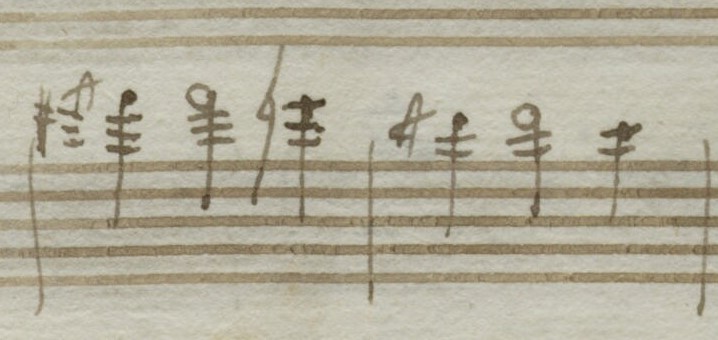Recently, David Perry, a Canadian violinist, criticised what he considered to be a wrong appoggiatura note in my Urtext edition of the Mozart A-major Violin Concerto K. 219, concerning measure 69 in the first movement. In Mozart’s autograph there seems to be no doubt about the appoggiatura note a2 to the main note d3:

Mozart, Autograph, Violin Concerto in A major, K. 219, mm. 68/69 Washington, Library of Congress, online-scan: Image 15/101
Mr Perry was bothered not only by the appoggiatura note at the interval of a fourth, which is unusual for Mozart, not to say impossible, but he also referred to the – usual – grace-note writing in the prior measure and to the parallel passages in mm. 170/171.
The appoggiatura note at the fourth is indeed strange, but that’s the way it is, and it fits perfectly into the harmony (a2 is to be heard here on all modern recordings of K. 219). And that’s why it is also reproduced in our Urtext edition exactly so (as, incidentally, it is also to be found in the Bärenreiter edition), with my additional “cautionary” footnote: “The contrasting appoggiaturas in mm. 68/69 and 170/171 are reproduced exactly as they appear in the autograph.”
I was about to compose a friendly and regretting email when, on close inspection of the autograph passage, I suddenly noticed that the appoggiatura note in question is notated “too high”, that is, on the SAME leger line as the main note’s upper leger line. If Mozart really wanted to write and hear the appoggiatura fourth a2, then he would have written the leger line and with it the entire grace note lower. And then it was clear to me that Mozart simply forgot to write the lower leger line. It is APPARENTLY a2 but meant to be the expected c#3. I’m quite sure about that: missing there is simply the bottom leger line.
Dear violinists: You are welcome to take the (rewarding) time to leaf through the whole Mozart autograph. This movement is teeming with grace notes. As usual, they are all at the interval of a second from above or below. And Mozart always writes the notes, including the leger line(s), exactly at the level of the respective main note. In m. 69, too, but missing only here, unfortunately, is the bottom leger line.
So, from now on, you should correct the erroneous a2 in m. 69 to the correct c#3. And in our next Urtext edition of this work, I shall correct this annoying little error. Thank you, David Perry!

Another theory: Mozart started to write the C-sharp appoggiatura but grew disenchanted with it and left off before he was finished. The C-sharp makes the measure match the previous one too much and anticipates the C sharp at the end of the measure. An E appoggiatura creates a more complex and beautiful relationship, in that it repeats the final note of the previous measure, just as did the previous E sharp appoggiatura. So when he wrote out the phrase exactly in the recapitulation, he was sure of the E and wrote it in very clearly. Then, as so often happens in these cases, he forgot to go back and correct the first instance.
Earlier editors let aesthetics be their guide, assumed that the A (or C-sharp) was an error, and engraved E in both cases. I hope that present performers continue to play the traditional E.
Dear Mr. Ruggero, thank you for your comment. Musically I am 100% with you: also for me only the E sounds really convincing here. (But) we editors have the duty to represent the authorized text, no matter if we like it or not. “Aesthetics” can be a very dangerous “guide” and eventually contradict the idea of Urtext. In this very case I will add a footnote that opts for E instead of the written imperfect C#. I do hope that you can live with it 🙂
Footnotes such as you suggest, which point out a likely intention even if unprovable, are immensely important. Many players do not carefully read critical notes (assuming that the issue is addressed there) and thus do not even consider textual problems such as this one. They just blindly play the text as given and risk becoming what I call “urtext victims.” The literature is full of examples!
Dear violinists: You are welcome to take the (rewarding) time to leaf through the whole Mozart autograph.
Aaron Copland: “To stop the flow of music would be like the stopping of time itself, incredible and inconceivable.”